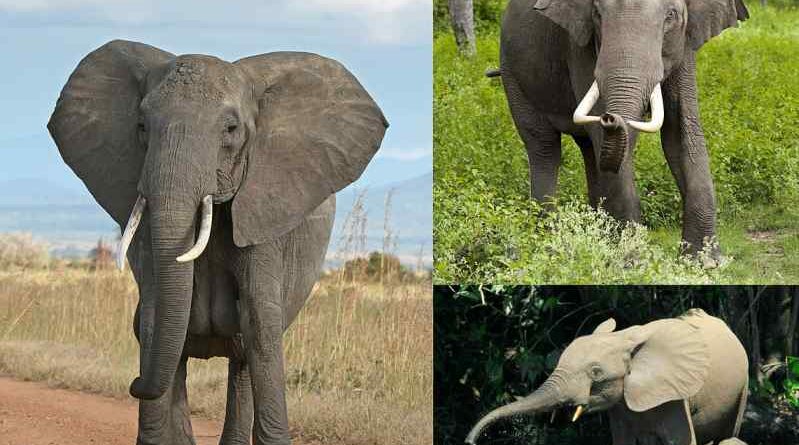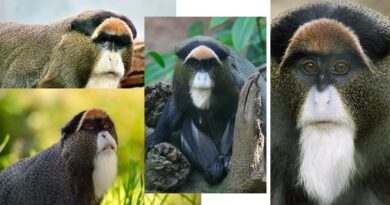ELEPHANT
The trunk is the most interesting thing about an elephant. If you can imagine having the end of your nose and your upper lip pulled further and further away from your face, you can get an idea of how the trunk of an elephant has changed over millions of years. It got stronger as it got longer. It has more than 60,000 muscles now, and the elephant uses its trunk in a lot of different ways.
Its main job is to stretch out and gather food for the animal, like grass, leaves, shoots, twigs, and fruits. The end of the trunk curls around the food, grips it tightly, plucks it, and then brings it to the open mouth. This action is done over and over, day after day, over and over again. At least eighteen of the elephant’s twenty-four hours are spent eating. People also drink from the trunk.
The animal drinks about 7 litres of water into it, closes the tip, and then pushes it into its mouth. There, it squirts the liquid right down its throat. If there is enough water, a full-grown elephant will drink between 135 and 225 litres of water every day. When there isn’t enough water, the trunk is used to sniff the ground for water that is deep below the surface. If it finds a good spot, the animal digs with its huge tusks until it has made a hole deep enough to get a little liquid.
The tusks are two upper teeth that have grown bigger and longer over time. They are also used to strip the bark off of trees. The tusks are now huge tools that are used for eating and fighting. The longest tusk that has ever been seen was almost 3.5 metres long, but tusks that big are rare. Most of the time, they only get about half that long. When the elephant wants to move something heavy, like a log, it uses both its tusks and its trunk like a fork-lift truck. When bathing, the trunk is also used.
Elephants have skin that is 2 centimetres thick and needs to stay healthy. They like to take a bath every day. When they do this, water shoots over their backs. This also keeps them cool when it’s very hot outside. If they are in a mud wallow, they use the trunk to spray liquid mud on their skin. This dries like a mud pack and helps kill skin pests and protect the surface of the animal. When taking a dust bath, the trunk is used to spread dust over the skin if the earth is very dry.
Elephants are good swimmers, which may come as a surprise. When they are in deep water, they use their trunks like snorkel tubes and hold them high in the air. When they are on dry land, they also raise them up if they smell something high. They can quickly figure out where the smell is coming from by turning the tip in different directions. If it means danger, they can take action before the threat is too close.
Since the trunk is like a super-nose, elephants can use it to sniff anything they touch and learn a lot about it. It’s amazing to see such a big animal sniff a small flower with care or lightly brush the end of its trunk against the face of a friend.
The trunk is used to caress other elephants during courtship and when friends are meeting. With the sensitive tip of the trunk, mothers can feel their babies all over to check on them. When elephants fight, they sometimes use their trunks to hit each other. Elephants use their trunks as trumpets in another way when they are scared. When they scream through their long “noses,” the hollow tubes inside the trunk make it sound like a wind instrument.
So the elephant’s trunk is a nose, a lip, a firm hand, a strong arm, a powerful hosepipe, a snorkel tube, and a loud trumpet, all in one. It is one of the most interesting parts of an animal’s world. We may be amazed by the elephant’s trunk and all the things it can be used for, but the animal’s biggest claim to fame has to be its size. Elephants are the biggest land animals on Earth. A big male can weigh up to 6,000 kilos, and when it is born, a baby elephant is heavier than a grown man.
The fact that elephants are so big helps them in two ways. It makes them reach high up in the trees when they are looking for food. It also makes it difficult for dangerous animals like lions, tigers, and wild dogs to attack them. Hunting animals can only catch a baby elephant right after it is born, and even then, there isn’t much chance of success because the adult elephants stand guard over the baby and protect it from harm.
A pregnant elephant stays pregnant for almost two years, which is longer than any other animal. When the baby is born, the mom’s friends are there to help. These act as midwives, gathering around the baby to clean it, help it stand up, and protect it from any dangers that might be nearby. At this time, it would take a brave killer to walk up to a group of females. Adult female elephants live in close groups and always move around together.
The group is made up of several sisters, their young elephants, and probably an old grandmother elephant. This grandmother runs the group and is in charge. If there is even a hint of danger, like a strange smell or a strange, unexpected movement in the distance, she is the one who faces it, while the others crowd around her calves. In Victorian times, big game hunters who went elephant hunting thought she must be the bull elephant because she is the biggest of the females and is so brave when protecting her small herd. In those days, they were so used to the idea that the male was the head of the family that they couldn’t believe a female could be the boss.
Years later, when people started learning more about wild elephants, they found that the bulls live alone, away from the family group. They are bigger than the female group leader. A big bull could easily beat a big cow in a one-on-one fight and move over as the leader of the herd. But it’s not that simple because if he tried to do that, all the females would work together to stop him. “Strength in numbers” is the golden rule for female elephants. The males are only allowed to join the herd when the females are ready to mate. After that, they have to leave and go back to living on their own. Males sometimes live together in a loose herd, but this doesn’t last long, and they don’t help each other like the females do. The baby elephant grows up very quickly after it is born. It stays on its mother’s milk for more than three years, sucking the liquid with its mouth instead of its trunk. Once it is weaned, it won’t ever put food in its mouth this way again. It will always reach for food with its trunk first, then move it to its mouth.
By the time the baby elephant is six years old, it will weigh ten times as much as it did when it was born. It will start making more of itself after four years. If it is a female, it will have a new calf every three years until it dies or gets too old to breed. Some elephants live almost as long as years, but most of them are lucky to make it to thirty.
There is a romantic story that says elephants go to a sacred place called “the elephants’ graveyard” when they are about to die. Explorers would sometimes find a lot of elephant bones lying together on the ground, which led to the story. The sad truth about these graveyards is that they are places where hunters killed whole herds of animals and left their dead bodies to rot. A fact that isn’t very romantic is that when an elephant dies, it dies right where it is.
Too many of them have been dropping in the last few months. A little more than ten years ago, there were more than a million elephants in Africa. Poachers have killed half of them since then. Ivory was what these men wanted. The rest of the elephant’s body was left where it had fallen. They stole the big, curved tusks and smuggled them to the Far East, where carvers turned them into expensive ornaments. The people who sold ivory got rich, and they didn’t care what happened to the elephants as long as there were more in Africa to kill.
In the end, there were so few elephants left that the world agreed to stop selling ivory. This helped a little, but the most dangerous poachers still went out at night and stole Africa’s most important animal. The Asian elephant can’t be killed in large animals because there are already so few of them left. At the last count, there were less than 50,000 left on the continent as a whole. They live in small, remote parts of the forests of India, Sri Lanka, Indochina, Malaysia, southern China, and parts of Indonesia.
Only the Asian and the African elephants are still around today. They are very similar, but there are a few differences. The Asian’s forehead is rounded, while that of the African is flat. The Asian one holds its head low and has a hump on its back. The African one holds its head higher and has a small dip in the middle of its back. The ears on the Asian elephant are smaller than those on the African one. (This is because elephant ears are used to cool the body, and African elephants are more affected by heat than Asian elephants.) The female Asian elephant’s tusks are so small that you can’t see them outside of her mouth. On the other hand, the female African elephant’s tusks, which are smaller than the male’s, can be seen from far away. The Asian elephant is a little bit smaller than the African elephant, and it is also easier to train.
Asian elephants have been used since ancient times to clear forests, take part in ceremonies, fight in wars, carry heavy loads, and perform in circuses. The African elephant doesn’t have to do these difficult things because it is much harder to control. You can be sure of one thing by the time you read these words: there will be a lot fewer elephants in the world. After millions of years, these huge animals are about to go extinct. We are very lucky to be alive while they are still around so we can marvel them and spend time with them.



